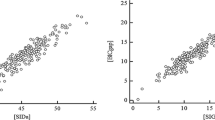Abstract
Purpose
To place in context the potential value of isolated plasma strong ion difference (SID) calculations and strong ion gap (SIG) calculations versus suggested cut-down versions such as SIDa adj and the BICgap respectively.
Methods
Stewart’s physical chemical approach is seen as a mathematical model of isolated plasma not displacing traditional Copenhagen and Boston approaches. Scanning tools for unmeasured ions based on the Principle of Electrical Neutrality such as the SIG and suggested cut-down versions such as the albumin adjusted anion gap and the BICgap are evaluated for accuracy and clinical usefulness.
Results
Plasma SID and abbreviations such as SIDa adj are not independent variables in vivo since they vary with PCO due to Gibbs Donnan ion traffic. They can also exhibit positive and negative bias, and SID values must be partnered with non-volatile weak acid concentrations when evaluating metabolic acid-base status. The BICgap calculation is a cut down version of the SIG fixed for pH 7.4. It includes phosphate but is otherwise similar in form to the albumin corrected anion gap, with similar sensitivity and specificity characteristics.
Conclusions
Clinicians are unlikely to find SID calculations or cut-down versions such as the SIDa adj clinically useful. The albumin corrected anion gap is in current use and easily determined by mental arithmetic from point of care anion gap printouts plus recent plasma albumin measurements. Any slight advantage of the BICgap would be offset by the complexity of its calculation.
Similar content being viewed by others
References
Narins RG, Emmett M. Simple and mixed acid-base disorders: a practical approach. Medicine. 1980;59(3):161–87.
Siggaard-Andersen O, Fogh-Andersen N. Base excess or buffer base (strong ion difference) as measure of a non-respiratory acid-base disturbance. Acta Anaesthesiol Scand. 1995;39:123–8.
Schlichtig R, Grogono AW, Severinghaus JW. Human PaCO2 and standard base excess compensation for acid-base imbalance. Crit Care Med. 1998;26(7):1173–9.
Figge J, Jabor A, Kazda A, Fencl V. Anion gap and hypoalbuminemia. Crit Care Med. 1998;26(11):1807–10.
Stewart PA. How to understand acid-base. A quantitative acid-base primer for biology and medicine. New York: Elsevier; 1981. p. 368.
Stewart PA. Modern quantitative acid-base chemistry. Can J Physiol Pharmacol. 1983;61(12):1444–61.
Stewart PA. Independent and dependent variables of acid-base control. Respir Physiol. 1978;33(1):9–26.
Kellum JA. Clinical review: reunification of acid-base physiology. Crit Care. 2005;9(5):500–7. https://doi.org/10.1186/cc3789.
Morgan TJ. The Stewart approach–one clinician’s perspective. Clin Biochem Rev. 2009;30(2):41–54.
Kurtz I, Kraut J, Ornekian V, Nguyen MK. Acid-base analysis: a critique of the Stewart and bicarbonate-centered approaches. Am J Physiol Renal Physiol. 2008;294(5):F1009–31. https://doi.org/10.1152/ajprenal.00475.2007.
Figge J, Mydosh T, Fencl V. Serum proteins and acid-base equilibria: a follow-up. J Lab Clin Med. 1992;120(5):713–9.
Morgan TJ. The meaning of acid-base abnormalities in the intensive care unit: part III—effects of fluid administration. Crit Care. 2005;9(2):204–11. https://doi.org/10.1186/cc2946.
Gattinoni L, Carlesso E, Cadringher P, Caironi P. Strong ion difference in urine: new perspectives in acid-base assessment. Crit Care. 2006;10(2):137. https://doi.org/10.1186/cc4890.
Yunos NM, Bellomo R, Story D, Kellum J. Bench-to-bedside review: Chloride in critical illness. Crit Care. 2010;14(4):226. https://doi.org/10.1186/cc9052.
Langer T, Scotti E, Carlesso E, Protti A, Zani L, Chierichetti M, Caironi P, Gattinoni L. Electrolyte shifts across the artificial lung in patients on extracorporeal membrane oxygenation: interdependence between partial pressure of carbon dioxide and strong ion difference. J Crit Care. 2015;30(1):2–6. https://doi.org/10.1016/j.jcrc.2014.09.013.
Wolf MB, Deland EC. A comprehensive, computer-model-based approach for diagnosis and treatment of complex acid-base disorders in critically-ill patients. J Clin Monit Comput. 2011;25(6):353–64. https://doi.org/10.1007/s10877-011-9320-2.
Morgan TJ, Vellaichamy M, Cowley DM, Weier SL, Venkatesh B, Jones MA. Equivalent metabolic acidosis with four colloids and saline on ex vivo haemodilution. Anaesth Intensive Care. 2009;37(3):407–14.
Agrafiotis M, Mpliamplias D, Papathanassiou M, Ampatzidou F, Drossos G. Comparison of a new simplified acid-base tool to the original Stewart-Figge approach: a study on cardiac surgical patients. J Anesth. 2018;32(4):499–505. https://doi.org/10.1007/s00540-018-2503-y.
Jones NL. A quantitative physicochemical approach to acid-base physiology. Clin Biochem. 1990;23(3):189–95.
Kellum JA, Kramer DJ, Pinsky MR. Strong ion gap: a methodology for exploring unexplained anions. J Crit Care. 1995;10(2):51–5.
Venkatesh B, Pilcher D, Prins J, Bellomo R, Morgan TJ, Bailey M. Incidence and outcome of adults with diabetic ketoacidosis admitted to ICUs in Australia and New Zealand. Crit Care. 2015;19(1):451. https://doi.org/10.1186/s13054-015-1171-7.
Peterson CD, Collins AJ, Himes JM, Bullock ML, Keane WF. Ethylene glycol poisoning: pharmacokinetics during therapy with ethanol and hemodialysis. N Engl J Med. 1981;304(1):21–3.
Gonda A, Gault H, Churchill D, Hollomby D. Hemodialysis for methanol intoxication. Am J Med. 1978;64(5):749–58.
Kellum JA. Determinants of plasma acid-base balance. Crit Care Clin. 2005;21(2):329–46. https://doi.org/10.1016/j.ccc.2005.01.010.
Morgan TJ, Anstey CM, Wolf MB. A head to head evaluation of 8 biochemical scanning tools for unmeasured ions. J Clin Monit Comput. 2017;31(2):449–57. https://doi.org/10.1007/s10877-016-9861-5.
Anstey CM. Estimating the net effect of unmeasured ions in human extracellular fluid using a new mathematical model. Part II: practical issues. Anaesth Intensive Care. 2010;38(5):870–5.
Author information
Authors and Affiliations
Corresponding author
Additional information
Publisher's Note
Springer Nature remains neutral with regard to jurisdictional claims in published maps and institutional affiliations.
Rights and permissions
About this article
Cite this article
Morgan, T.J. Reducing complexity in acid–base diagnosis - how far should we go?. J Clin Monit Comput 34, 17–20 (2020). https://doi.org/10.1007/s10877-019-00319-7
Received:
Accepted:
Published:
Issue Date:
DOI: https://doi.org/10.1007/s10877-019-00319-7




